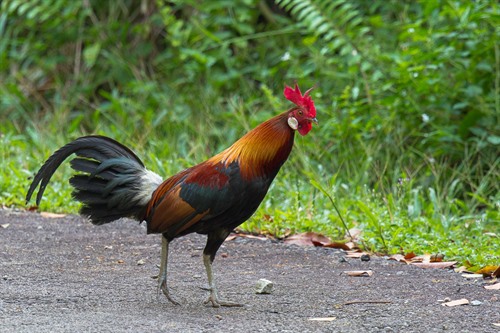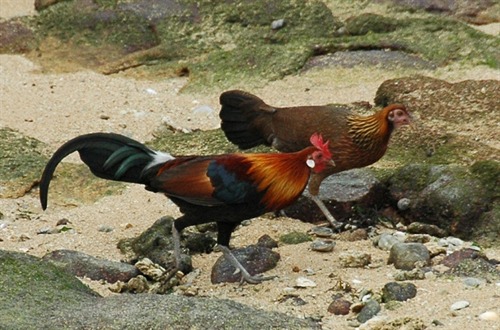
Back
Gallus gallus Linnaeus, 1758
| Family Name: | Phasianidae |
| Taxonomic Group: | Vertebrates (Bird) |
| Common Name: | Red Junglefowl |
Name
Description
| Description | The Red Junglefowl resembles the domestic chicken, but have grey feet and brighter plumage. Males have bright orange hackles, a green tail, and a white ear patch. Females are brown, have a shorter tail and a smaller ear patch than the males. In Singapore, hybridization between the wild junglefowl and the domestic chicken is quite common. |
|---|
Ecology, Habitat & Location
| Ecological Notes | Occurs in secondary forest, scrub, mangrove and plantations. This species is the only one in Singapore which has a complex social order typical of its family. Flocks consist of a dominant male, immature males and females, a harem of adult females and juveniles and can total up to 20. Forages exclusively on the ground for grains, roots and small invertebrates. Nest is a scape on the ground and can contain up to 20 eggs. Care of the young is left entirely to the mother although elder "siblings" do help out. Roosts in trees at night. |
|---|---|
| Habitats | Forest, Mangroves, Terrestrial |
| Distribution | True wild birds are found only on Pulau Ubin (from the mid 1980s onwards) and in the Western Catchment (since about 2000). A few birds, some of them hybrids, have been introduced at Sungei Buloh since the late 1990s and breeding has been recorded. Sightings have also been obtained from the West Coast and Sentosa in the late 1990s but the origin of these birds is debatable. The species is also found from the western Himalayas, southern China to Southeast Asia. |
| Nature Areas | Pulau Ubin, Western Catchment Area |
Conservation
| Trends & Threats | Habitat loss and disturbance. The other threats are poaching (being a ground dweller they are extremely vulnerable to noose traps) and interbreeding with domestic fowls. However, the latter threat has been reduced with the recent (2005) culling of domestic fowls on Pulau Ubin. |
|---|---|
| Scientific Interest & Potential Value | Potential genetic stock for improving stocks of captive poultry. |
| Conservation Notes | Estimated at between 50-100 birds. Suitable sites, e.g. Tanjong Tajam, have already been suggested as conservation areas in 1990. Key sites for this species in Ubin should be set aside as fully protected bird sanctuaries. Any development plans for the island should take into account the preservation of sufficient areas for this species. |
Status
| Species Status | Resident |
|---|---|
| Conservation Status | Uncommon |
| Singapore Red Data Book Status | Endangered (EN) [2008] |
Photos
References
| References | Davison, G.W.H., Ng, P.K.L. & Ho, H.C (Eds.). 2008. The Singapore Red Data Book (2nd Edition). Singapore: Nature Society (Singapore). 285pp Wang, L.K. & Hails, C.J. 2007. An annotated checklist of the birds of Singapore. Raffles Bulletin of Zoology Supplement no. 15. 179pp Yong, D. L., Lim, K. C., & Lee, T. K. 2013. A Naturalist's Guide to the Birds of Singapore . United Kingdom: John Beaufoy Publishing. 176 |
|---|

